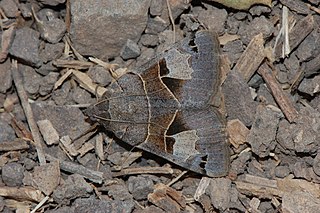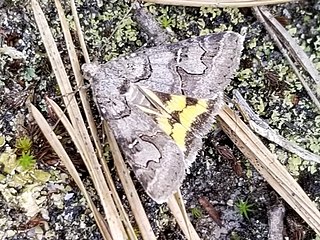
Drasteria is a genus of moths in the family Erebidae.

Drasteria cailino is a moth of the family Erebidae first described by Alexandre Louis Lefèbvre de Cérisy in 1827. It is found in southern Europe, the Near East and Middle East up to the western Himalayas in the east. In the Levant, several isolated populations are present in Lebanon, Syria and Israel.
Drasteria hudsonica, the northern arches, is a moth of the family Erebidae. The species was first described by Augustus Radcliffe Grote and Coleman Townsend Robinson in 1865. It is found from Alaska and Yukon to California, east to New Mexico and Manitoba.
Drasteria petricola, the little arches, is a moth of the family Erebidae. The species was first described by Francis Walker in 1858. It is found in western North America from Yukon and the Northwest Territories south to New Mexico in the Rocky Mountains, east to Manitoba.

Drasteria howlandii is a moth of the family Erebidae. It is found from British Columbia and Saskatchewan south through the western parts of the United States from Washington south to Arizona and Texas.
Drasteria hastingsii is a moth of the family Erebidae. It is found from British Columbia south to Oregon and California.
Drasteria tejonica is a moth of the family Erebidae. It has been recorded from California, Arizona, Colorado, Utah and New Mexico.

Drasteria edwardsii is a moth of the family Erebidae. It is found from Washington, through Oregon to California.

Drasteria fumosa, the smoky arches, is a species of moth in the family Erebidae first described by Strecker in 1898. It is found from the US state of California east to Utah and Texas.

Drasteria graphica, the graphic moth, is a moth of the family Erebidae. The species was first described by Jacob Hübner in 1818. It is found in the United States in coastal dunes from Maine to Florida, west to Mississippi. It is also found along the shores of the Great Lakes in Michigan and Wisconsin. Subspecies D. g. atlantica is listed as threatened in Connecticut.
Drasteria inepta, the inept drasteria, is a moth of the family Erebidae. It is found from Arizona to Texas, north to Colorado and Utah.

Pyrgus cashmirensis is a butterfly of the family Hesperiidae. It is found in Tajikistan, north-eastern Afghanistan, northern Pakistan and Kashmir.
Drasteria yerburyi is a moth of the family Erebidae. It is found in Somalia, Eritrea, the United Arab Emirates, Yemen and Iran.

Drasteria philippina is a moth of the family Erebidae. It is found on the Canary Islands, as well as in Morocco, Algeria, Libya, Egypt, Israel and Malta.
Drasteria antiqua is a moth of the family Erebidae. It is found in Kyrghyzstan and Mongolia.
Drasteria habibazel is a moth of the family Erebidae. It is found in Tunisia.
Drasteria occulta, the occult drasteria moth, is a moth of the family Erebidae. The species was first described by Henry Edwards in 1881. It is found in North America, where it has been recorded from coastal areas in Maine, New Jersey, Pennsylvania and Texas. It is listed as a species of special concern and believed extirpated in the US state of Connecticut.
Drasteria pamira is a moth of the family Erebidae first described by Oscar John in 1917. It is found in Kyrgyzstan, Tajikistan and Afghanistan.

Drasteria picta is a moth of the family Erebidae first described by Hugo Theodor Christoph in 1877. It is found in Ukraine, Russia, Kazakhstan, southern Turkey, Syria, Armenia, Daghestan, Kyrgyzstan, Uzbekistan, Turkmenistan, Mongolia and China.
Drasteria pictoides is a moth of the family Erebidae. It is found in Syria and the southern Caucasus.







